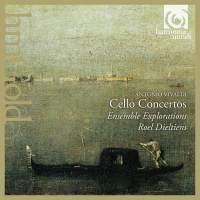Texte paru dans: / Appeared in: |
|
|
Outil de traduction |
|
|
|
|
|
Reviewer: Robert
Maxham The period performance movement has empowered players to experiment with novel sonorities, isolated and in combination. Their newfound variety mirrors both Vivaldi's own formal variety and the variegated textures inherent in his scores, even when performed by groups of seemingly limited timbrai range. Ensemble Explorations seems to be exploring just such new territory in the Cello Concertos. For example, they alternate harpsichord and organ in a single work (starting with the one in A Minor, the first on the recording—and, according to the notes provided by Peter Wollny, also perhaps the first in order of composition, bearing both traces of the sonata and a simpler accompaniment; there's a precedent: Corelli's Concerti grossi represent reworkings of trio sonatas). The energy with which they play these pieces results neither from rapid tempos nor from special buoyancy but from a sharp rhythmic sense reinforced by incisive rather than ponderous downbeats. Against this backdrop, Roel Dieltiens sets solos by turns amiably crunchy and beguilingly lyrical. An occasional noisy portamento that might ruin a passage written a century later matters less in this context. Harmonia Mundi's engineers have placed Dieltiens in the midst of the Ensemble, which consists only of string quartet, bass, alternate organ and harpsichord, and alternate theorbo and guitar. So nothing seems to be too far away; and the ambiance reflects what must have been the intimacy of a small ensemble performing in a room rather than in an auditorium. Though she lacks both Dieltiens's strong rhythmic articulation and his robust tone, violinist Christine Busch serves as an effective foil in the Concerto, "Il Proteo," as well as in the Concerto, RV 561, for the same forces, both of which II Giardino Armonico has included in a collection on Teldec 4509-94552-2. The finale of "Il Proteo" (like the slow movement and finale of the Concerto RV 561) offers evidence for what can be extracted from Vivaldi's scores. Although II Giardino plays that finale with unabashed virtuosity, Ensemble Explorations outdoes Giardino in nuance—and Harmonia Mundi's engineers have provided a more reverberant acoustic backdrop for the Ensemble's richer, less acerbic textures. Like II Giardino Armonico, Pieter Wispelwey and Florilegium sound more astringent in a completely different set of Cello Concertos (except for the slow movement of RV 407, which they amalgamate, with movements from the Concertos RV 410 and 411, to create a new Concerto) on Channel Classics CCS 10097. An even more startling contrast, however, exists between Dieltiens's performances and those of the more traditional City of London Sinfonia with Raphael Wallfisch as soloist—they included RV 407 in Volume 3 of Naxos's collection of Vivaldi's Cello Concertos (8.550909). Ensemble Explorations enjoys a strong enough advantage over the Sinfonia in both tonal weight and texrural nuance to suggest analogies to an additional dimension. Standing on the shoulders of earlier recreators of Vivaldi Concertos, Dieltiens and his ensemble seem to have glimpsed a more distant vision. For the exhilaration of that vision alone, their performances recommend themselves to all sorts of listeners. | |
|
|
|
|
|
|
|
Cliquez l'un ou l'autre
bouton pour découvrir bien d'autres critiques de CD |
|




